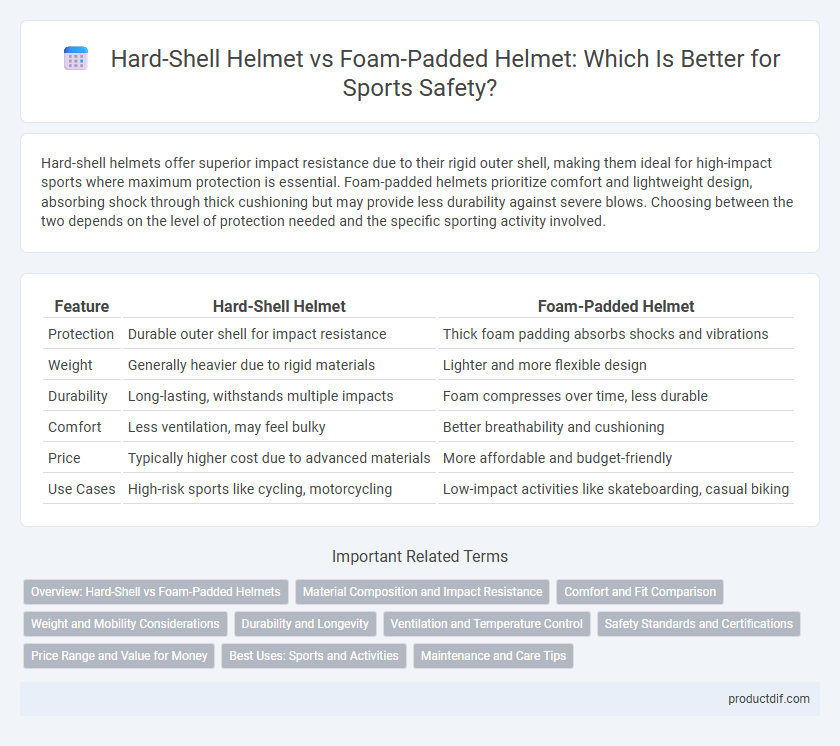Hard-shell helmets offer superior impact resistance due to their rigid outer shell, making them ideal for high-impact sports where maximum protection is essential. Foam-padded helmets prioritize comfort and lightweight design, absorbing shock through thick cushioning but may provide less durability against severe blows. Choosing between the two depends on the level of protection needed and the specific sporting activity involved.
Table of Comparison
| Feature | Hard-Shell Helmet | Foam-Padded Helmet |
|---|---|---|
| Protection | Durable outer shell for impact resistance | Thick foam padding absorbs shocks and vibrations |
| Weight | Generally heavier due to rigid materials | Lighter and more flexible design |
| Durability | Long-lasting, withstands multiple impacts | Foam compresses over time, less durable |
| Comfort | Less ventilation, may feel bulky | Better breathability and cushioning |
| Price | Typically higher cost due to advanced materials | More affordable and budget-friendly |
| Use Cases | High-risk sports like cycling, motorcycling | Low-impact activities like skateboarding, casual biking |
Overview: Hard-Shell vs Foam-Padded Helmets
Hard-shell helmets feature a rigid outer layer typically made from polycarbonate or fiberglass, providing superior impact resistance and protection in high-speed sports like cycling or skiing. Foam-padded helmets rely on layers of expanded polystyrene (EPS) or similar cushioning materials to absorb shock, offering lightweight comfort and enhanced ventilation suitable for activities such as skateboarding and casual biking. Both helmet types comply with safety standards like CPSC or ASTM, but hard-shell variants generally offer increased durability while foam-padded helmets prioritize breathability and weight reduction.
Material Composition and Impact Resistance
Hard-shell helmets feature a rigid outer shell composed of polycarbonate or fiberglass, providing superior impact resistance by dispersing force over a larger area. Foam-padded helmets utilize expanded polystyrene (EPS) foam liners designed to absorb and dissipate energy upon impact, offering enhanced shock absorption but less structural durability against penetrating forces. Material composition directly influences protection levels, with hard-shell helmets excelling in preventing penetration and foam-padded helmets optimizing energy absorption for blunt impacts.
Comfort and Fit Comparison
Hard-shell helmets provide enhanced impact resistance with a rigid outer layer, offering superior protection during high-impact sports, but they can feel heavier and less flexible compared to foam-padded helmets. Foam-padded helmets focus on comfort with lightweight materials and better ventilation, ensuring a snug fit that reduces pressure points and enhances breathability. Choosing between hard-shell and foam-padded helmets depends on balancing protection needs and comfort preferences during activities like mountain biking or skateboarding.
Weight and Mobility Considerations
Hard-shell helmets typically offer superior durability and impact resistance but tend to be heavier, which can reduce mobility and increase fatigue during prolonged sporting activities. Foam-padded helmets prioritize lightweight design and enhanced comfort, allowing greater agility and ease of movement, especially in fast-paced sports. Athletes must balance the need for protection with the benefits of reduced weight to optimize performance and safety.
Durability and Longevity
Hard-shell helmets offer superior durability and longer lifespan due to their rigid outer shell that resists impact and abrasions effectively. Foam-padded helmets provide cushioning comfort but may degrade faster over time because the foam materials are prone to compression and wear. Choosing a hard-shell helmet is ideal for athletes requiring extended protection and enhanced resilience during rigorous sporting activities.
Ventilation and Temperature Control
Hard-shell helmets provide superior ventilation through multiple strategically placed vents that promote airflow and heat dissipation, making them ideal for high-intensity sports in warm conditions. Foam-padded helmets, while offering enhanced impact absorption, often restrict airflow due to denser padding, potentially leading to increased heat buildup and discomfort during prolonged use. Choosing the right helmet involves balancing protection with temperature control needs, especially for activities requiring extended wear in variable climates.
Safety Standards and Certifications
Hard-shell helmets, certified by rigorous safety standards such as ASTM F1447 and CPSC, offer superior impact resistance and durability, making them ideal for high-impact sports. Foam-padded helmets, often meeting EN 1078 and Snell B90 certifications, provide enhanced shock absorption and comfort but may have limited protection under extreme collision scenarios. Choosing a helmet with appropriate certifications ensures optimal safety compliance and risk reduction during sporting activities.
Price Range and Value for Money
Hard-shell helmets typically range from $50 to $150, offering robust impact protection and superior durability, making them ideal for high-impact sports and long-term use. Foam-padded helmets usually cost between $20 and $70, providing lightweight comfort and adequate cushioning for low-impact activities but with less durability. Evaluating value for money, hard-shell helmets deliver greater safety investment despite higher upfront costs, while foam-padded helmets suit budget-conscious users prioritizing comfort and ease of replacement.
Best Uses: Sports and Activities
Hard-shell helmets are ideal for high-impact sports like cycling, skateboarding, and mountain biking due to their rigid outer shell that provides superior protection against penetration and severe collisions. Foam-padded helmets suit lower-impact activities such as casual biking, rollerblading, and recreational skating, offering lightweight comfort and shock absorption for minor falls and bumps. Selecting the right helmet depends on the intensity of the sport, with hard-shell models favored for aggressive sports and foam-padded helmets preferred for everyday recreational use.
Maintenance and Care Tips
Hard-shell helmets require regular inspection for cracks and dents, with cleaning done using mild soap and water to preserve the outer shell's integrity. Foam-padded helmets need careful drying after use to prevent foam degradation and should be protected from excessive moisture and direct sunlight. Both types benefit from consistent strap and buckle checks to ensure safety and longevity.
Hard-shell helmet vs Foam-padded helmet Infographic

 productdif.com
productdif.com